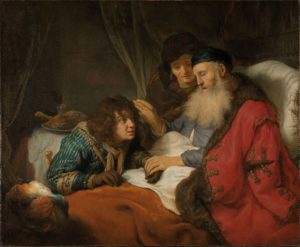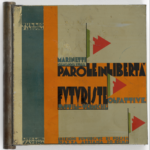Isaac Blessing Jacob
Govert Flinck, Isaac blessing Jacob, ca. 1638, (oil on canvas, 117cm × 141cm). Rijksmuseum, Amsterdam.
An allegory of the senses disguised as a biblical scene
This painting recounts the biblical story of Jacob impersonating as his brother Esau to trick his father Isaac into giving him his blessing. The twins are opposite in both personality and physique: whereas Esau likes to hunt and has crude manners, Jacob enjoys cooking and is highly refined. The idea to mimic Esau’s hairy arms by wearing a goat’s skin came from his mother Rebecca, who is observing the scene attentively from behind the bed.
The dim eyed Isaac is puzzled when he hears Jacob speaking, because it doesn’t sound like Esau’s voice, but he is increasingly convinced when he feels his hairy arms. While the tactile plot is highlighted by the artist by placing it at the centre of the canvas, the story is actually revolving around all the senses. After touching his disguised son, Isaac eats the food Rebecca prepared him, visible on the left, symbolizing the sense of taste. But the old man isn’t completely won over until he asks his son to come near him and kiss him. He then exclaims:
“See, the smell of my son is as the smell of a field that the Lord has blessed!”
Only when he perceives his eldest son’s odour Isaac is ready to give his blessing. Apparently Jacob foresaw that noses cannot be deceived, so he tied some of the hunting gear of his brother around his neck. Because Esau is often outside, In the fields, his clothes took on this characteristic scent. Flinck emphasized this insignificant piece of attire by putting its pale colour in stark contrast with the luxurious blue apparel.
What is interesting about this story and the painting is that the hierarchy of the senses seems to be reversed. The sense classically associated to knowledge and truth is eliminated because of Isaac’s blindness. Hearing – the other ‘higher’ sense – is put aside by Jacob, once he touches the fur, thinking it is skin. The tasting of the game plays a lesser role, but the sense of smell – usually esteemed as the lowest within western sensory hierarchies – is the most persuasive sense in the storyline.
Because of the active involvement of the five senses, and Flinck’s narrative style in which he carefully positions several sensory props, this painting might also be considered an allegory of the senses. The sense of smell is easily overlooked, and only traceable by (re)reading the story, because scent is simply invisible and hard to convey. This might partially explain why most artists choose to depict the tactile element of the story more prominently.
Caro Verbeek
Royal Academy of the Arts, The Hague
Vrije Universiteit Amsterdam
Mediamatic, Amsterdam


